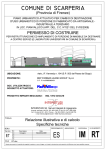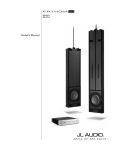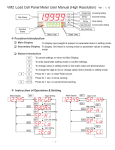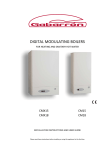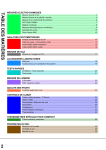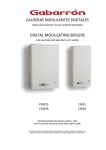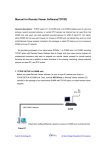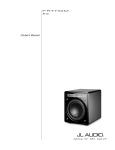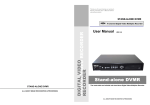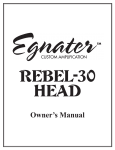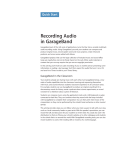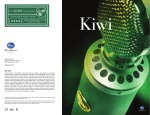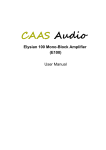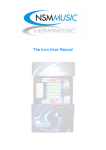Download Bottle Brochure 4 PDF
Transcript
Bottle Bottle C ongratulations on your purchase of the BLUE Bottle, a classic modern vacuum tube microphone made the old-fashioned way, without compromise. In every industry—cameras, automobiles, audio, and more—there are a handful of small companies reputed for a rare blend of scientific precision and artistic passion. You know who these artisans are; their trademarks are synonymous with the ultimate in hand-crafted perfection. Our flagship “The Bottle” microphone parallels this vision, representing BLUE’s highest achievement in quality and innovation. The Bottle is a precision recording tool, combining the low noise and superb transient response of top-grade electronics with the sonic magic of legendary vintage vocal microphones. The Bottle is not simply a microphone, but a fully featured microphone system with eight optional interchangeable capsules. In an instant, these bayonet-mount capsules can be exchanged to provide different tonal characteristics and pickup patterns—while the power supply is still turned on! The basic Bottle system includes a B6 cardioid capsule, Champagne tube microphone cable, and the 9610 Tube Mic power supply, shipped in a blue velvet-lined ATA flight case approved for the utmost protection. The Bottle is finished in a luxurious blue lacquer paint with other colors available by special order. Additional capsules are available from your pro audio dealer, and you’ll find a complete list of capsules detailed herein. In order to familiarize yourself with the Bottle’s specialized and unique features, please take the time to read this manual, and be sure to try the suggested recording tips. The Bottle One of the questions most commonly asked of BLUE Bottle microphone owners is, “What’s in that thing?” The Bottle is unquestionably an impressive sight, with its imposing size and nostalgic resemblance to the earliest European tube microphones. Like the mics of yesteryear, the Bottle canister is not just for looks, but also holds a small fortune in precision electronics. The internal circuitry of The Bottle is thoroughly modern, of course, with an amplifier design utilizing a single hand-selected vacuum tube pentode EF86 in triode mode. The tube circuit is Class A and fully discrete, meaning that the sound which arrives at the diaphragm of the BLUE capsule is transduced (converted to electrical energy) as accurately as possible, with no integrated circuits (a.k.a. “IC’s”) in the signal path. To this end, The Bottle utilizes electronic components of the highest quality (such as expensive metal-film resistors and a large custom-built transformer), and there are no pad or low-cut filter switches in the microphone circuit. In short, this is a signal path of the highest possible quality, allowing the user to get the maximum benefit out of the unprecedented capsule selection created by BLUE. In order to get the most out of this, or any quality microphone, it is essential to pair it with a good microphone pre-amplifier. Most professional recordists prefer to have outboard preamps on hand, and will choose solid-state or vacuum tube models based on their unique characteristics. And unlike many tube microphones, the Bottle can be run through a variety of tube preamps without excess coloration, noise, loss of detail or tube compression. To maintain the integrity of your signal, use the BLUE Kiwi mic cable going into the mic preamp. It is not necessary or advisable to connect the Bottle Mic 9610 power supply to a 48V phantom power source. And, whenever possible, connect the mic preamp output directly to your recorder or A/D converter, bypassing the mixing board and any unnecessary components. A recessed, threaded mic stand socket is built into the bottom of the Bottle canister, next to the multi-pin output jack. To put the Bottle on a stand, you may find it easiest to 1) loosen the boom stand arm or threaded end of the mic stand, 2) grasp the Bottle in one hand, and 3) screw the mic stand threads into the threaded mount. This procedure will eliminate any possibility of handling damage to the mic. Inside the Bottle SAFETY NOTE: Do not attach a capsule or the multi-pin Champagne cable to The Bottle until it has first been attached to a stand. Once the microphone body is secure, connect the Champagne cable to The Bottle and the 9610 power supply, and then turn on the 9610 to start the warm-up process. At the end of a session, be sure to turn off the 9610 power supply before disconnecting the Champagne cable. Capsule Exchange When you’re used to dealing with an assortment of tube microphones (each with its own mounting system and power supply, not to mention additional voltage transformers, fragile parts, and other quirks), you’ll really appreciate the simplicity and ease of the Bottle capsule system. Switching capsules is a painless 30-second operation which eliminates downtime or warm-up time, and will never interrupt the flow of a session. To secure the delicate capsule during transport and storage, three brass set screws are provided. These screws go into the solid metal ring around the circumference of the spherical grille, and should be in place when you take the capsule out of its protective bag. Remove these screws before mounting the capsule on the Bottle, and replace them at the end of a session, if desired. Installing a capsule is a simple, three-step operation. First, position the capsule over the metal stem at the top of the Bottle, aligning the J-shaped slot at the back of the capsule socket with the protruding pin on the stem. Second, push the capsule down onto the stem until the pin stops at the end of the long leg of the slot. There is a strong spring inside the capsule socket, so a little extra effort may be required at this stage. Third, give the capsule a clockwise twist on the stem, so that the pin locks into the short leg of the slot and holds the capsule securely. You will notice that the stem pivots back and forth over a range of about 45 degrees to aid in placement and angling of the capsule. When exchanging capsules, there is no need to turn off the 9610 power supply. A low-level audio signal is present whenever a capsule is removed, so it is good engineering practice to mute or turn down the microphone preamp gain and monitors before changing capsules. The Capsule Selection Individual commentaries on each capsule are provided by Skipper Wise, President of BLUE, and Myles Boisen (Head Engineer, Guerrilla Recording, Oakland, CA., and freelance writer/reviewer for Electronic Musician magazine). B0: CARDIOID LARGE DIAPHRAGM SINGLE BACKPLATE The Ultimate Big Vocal Sound The B0 is a bright single back plate capsule, tuned rather high like our Blueberry microphone. It is similar in tone to the B6, with an added sparkle of air in the extreme high end. To obtain the ultimate Big Vocal Sound, work the B0 close with a pop filter. —SW This capsule exhibits lots of cutting power and airy response, and is particularly useful for an enhanced pop music vocal presence requiring extended highs and lows. Along with the B5 this is BLUE’s brightest capsule, but it also offers dramatic low-end pickup like the B4 and B2. The B0 delivers a larger-than-life sound that expands on the tonality of the B6 and B7 capsules, with a more open pickup pattern and less rear rejection.— MB RECOMMENDED FOR: Background and lead vocals, voice-overs, distant miking of acoustic guitar or mandolin, percussion, any source where extended top end is featured. B1: CARDIOID SMALL DIAPHRAGM The Accuracy Plus Capsule The B1 has been designed to capture instruments with a detailed high end, and features a dip in response around 400 Hz to enhance the clarity of a program source.—SW I found the B1’s most notable characteristics to be sweet highs, abundant high end detail, extremely lifelike transient response, and an open, uncompressed sound that seems to add extra depth and dimension to any source. This capsule offers punchy bass pickup without extended or muddy lows, neutral off-axis response, and a lack of harshness that is extraordinary for a small diaphragm transducer. Compared to other BLUE cardioid capsules, the B1 is prone to ambient pickup of low end noise (air conditioning, rumble etc.), but it does perform well in distant miking situations, and is striking in its accuracy and pleasant timbre.—MB RECOMMENDED FOR: Nylon or steel-string acoustic guitar, piano, vibraphone, accordion, drum overheads, metal percussion, hi-hat, small pitched percussion such as toy piano or mbira, voice-overs, special vocal effects, room or ambient miking, Foley and sound effect recording. B2: FIGURE OF EIGHT LARGE DIAPHRAGM The Vintage Capsule The response of the B2 has been tailored to resemble the big, warm sound and open pickup pattern of a vintage ribbon microphone. When worked close this capsule is reminiscent of the “Bing Crosby Sound,” with soft highs and an enhanced proximity effect.—SW The B2 offers a thick and compressed tonality, with an aggressive upper midrange and big low end response on par with the B0 and B4 capsules. It has a distinctively mellow high end compared to other BLUE capsules, and does a remarkable job of capturing the gentle timbre and roomy pickup of a ribbon microphone (without the fragility or low output problems of a classic specimen). The proximity effect of this pattern is pronounced, and can be used to great effect on vocals and soloists, whether one is pursuing experimental modern techniques, or recalling historical recording styles.— MB RECOMMENDED FOR: Emulation of vintage saxophone, brass, guitar, or vocal sounds, jazz ensembles and horn sections, muted trumpet, flugelhorn and other low brass instruments, clarinet, overly bright or “edgy” instruments, room miking, acoustic bass, cello and other bowed string instruments, electric bass, clean or distorted electric guitar, pedal steel and slide guitar, whistling, organ. B3: CARDIOID MID-SIZED DIAPHRAGM The Neutral Capsule This is our most accurate, and, in a purely technical sense, “best” capsule. The B3 has a soft midrange boost to detail the center frequencies in a program source.—SW In the tradition of classical recording microphones, this capsule does little to flatter or enhance the recorded source, but rather “tells it like it is.” The high end response is smooth, with exemplary transient response, and midrange to low end pickup appears to be flat. Though its timbre is not dramatic compared to other BLUE capsules, the B3 is noteworthy for its uncommon ability to convey a source with neutrality and veracity, just as it may sound in the room.—MB RECOMMENDED FOR: Female vocals, distant miking of orchestral groups and instruments, banjo, mandolin, resonator guitar, jazz guitar, distorted electric guitar, electric bass, a natural or folky tone on nylon and steel-string acoustic guitar, oboe, bassoon and other double reeds, piano, organ. The B4’s sweet highs are never harsh or strident, and the bass response below 120 Hz is unusually robust for an omnidirectional microphone. This capsule’s smooth presence lift conveys an extra measure of high end detail and focus, preventing distant sounds from becoming overly diffuse or “washed out”. I call this the audiophile capsule; traditionally Perspex sphere microphones are highly regarded for distant miking of classical instruments and ensembles. And, along with the B0 and B2 capsules, the B4 offers maximum low-end pickup, ranking as a particularly useful and unique tool for studio recording. Expect some ambient pickup of low end noise (air conditioning, rumble etc.), and 4 to 8 dB lower output relative to other capsules.—MB RECOMMENDED FOR: Orchestral sounds, classical instrumentation, snare, bass drum, background vocals, organ, accordion, tuba and sousaphone, distant miking of any source, particularly bowed strings, clean electric guitar, and drums. B5: PRESSURE OMNI LARGE DIAPHRAGM The Presence Omni Frequency response peaks at 3-5kHz and 12-15kHz give this capsule a distinctively bright and incisive timbre. The B5 is particularly useful for close-miking acoustic guitar, yielding an characteristic classic rock/pop sound with a proximity-induced “thump” at 125 Hz.—SW The B5 is distinguished by super-detailed highs and attenuated lower midrange to bass response. Along with the B0 this is the brightest of the BLUE capsules, and can supply significant presence boosting on dull, quiet, or indistinct sources. Low end pickup and proximity effect are minimal compared to other capsules, making this an ideal candidate for close-miking many acoustic instruments.— MB RECOMMENDED FOR: Acoustic guitar, percussion, any highly transient sources, any acoustic sources that need very close miking or extra presence boosting to cut through a dense mix. B6: CARDIOID LARGE DIAPHRAGM DUAL BACKPLATE The BLUE Standard — The Modern Presence Vocal Sound This is our premium capsule, tuned to deliver a larger-than-life sound with extension in the lower and upper frequencies. Though designed primarily to achieve a world-class contemporary vocal sound, the B6 can also be utilized to add a glossy, produced sheen to saxophone, piano, and other acoustic lead instruments. To obtain the ultimate vocal sound, work the B6 close with a pop filter.— SW The big, modern tone and sharply-etched presence of the B6 exemplifies the BLUE sound. With a brighter response and more proximity effect than the B7, and less high or low end extension compared to the B0, this capsule is logically a standard first choice for vocals. It also has extreme presence and “grab” at distances of three feet or more for distant acoustic guitar miking, ambient percussion miking, and unconventional vocal treatments. The B6 has the highest sensitivity of any BLUE capsule, and delivers significantly hotter output than most condenser microphones.— MB B7: CARDIOID LARGE DIAPHRAGM SINGLE BACKPLATE The Classic Vocal Sound This single backplate capsule is our version of the unmistakably warm sound ascribed to the great 1950’s tube microphones. A boost in the upper midrange response brings out just the right amount of intimate detail for vocal tracks that demand extra presence.—SW The B7 has a familiar, classic tube microphone signature, characterized by smooth highs and a forward midrange that is ideally suited to vocals, saxophones, electric guitar, and other instrumental solos. It is the most understated of the BLUE large diaphragm vocal capsule trio, exhibiting a silky, compressed tone and less presence boost than either the B6 or B0. The natural high end response of this capsule is the perfect complement for midrangy or thin voices, as well as any rock/ soul/ blues/ jazz vocals that need to “sit in the mix.” — MB RECOMMENDED FOR: Lead vocals, background vocals, saxophone, flugelhorn, clean or distorted electric guitar, pedal steel and slide guitar, organ, conventional jazz recording. Overview of The Vocal Capsules First and foremost, the three BLUE large diaphragm vocal capsules (B0/ B6/ B7) have been designed to provide the commanding, upfront presence associated with the world’s best (and most expensive) vocal microphones. With shimmering, detailed highs, smooth midrange response, and controlled proximity effect (a bass boost inherent in all unidirectional mics), these capsules excel at delivering a vocal right to the front of the mix where it belongs. When processed with limiting and/or compression, as is standard practice for most pop productions, vocal tracks will generally be free of pumping and low end thumps. Acoustic guitar, hand percussion, drums, and other critical high end sources also shine in front of these capsules, gaining an extra measure of “air.” The extreme presence of the BLUE vocal capsules enables the most delicate instrumental sounds to cut through a mix, even when recorded at distances of three feet or more, and mixed at very low levels. Capsule Summary TYPE The B4 represents our finest craftsmanship, evoking an ethereal quality sought after by producers and engineers alike. The Perspex sphere which houses our small diaphragm capsule, hand-built by BLUE engineers, is a unique design made popular in the 1950’s on the RCA Red Seal series recordings. For room sounds and ambient drum recording, nothing parallels the sound of this capsule. —SW RECOMMENDED FOR: Lead vocals, background vocals, voice-overs, percussion, any source where extended top end is featured, piano, vibraphone, accordion, clean electric guitar, jazz guitar, distant miking of acoustic or resonator guitar, Foley and sound effect recording, extremely quiet sources. BY The Big Omni CAPSULE B4: PERSPEX SPHERE PRESSURE OMNI SMALL DIAPHRAGM Large diaphragm cardioid: B0 • B6 • B7 Large diaphragm figure of eight: B2 Large diaphragm omnidirectional: B5 Mid-sized diaphragm cardioid: B3 Small diaphragm cardioid: B1 Perspex sphere omnidirectional: B4 IN ORDER OF OUTPUT LEVEL (highest to lowest output) B6 • B7 • B3 • B2 • B0 • B5 • B1 • B4 HIGH END CHARACTERISTICS (brightest to darkest in terms of general treble response) B5 • B0 • B6 • B1 • B4 • B3 • B7 • B2 Maximum highs B5 • B0 Flat and/or natural highs B3 • B6 • B1 • B4 • B7 Diminished highs B2 LOW END CHARACTERISTICS (fattest to thinnest in terms of general bass response) B4 • B0 • B2 • B6 • B7 • B3 • B1 • B5 Maximum lows B4 • B0 • B2 Flat and/or natural lows B6 • B7 • B1 • B3 Diminished lows B5 highs, or turn it toward the edge of the cone for a fuller sound with more low end. You should also try the B2, B3, and B7 for overdriven or distorted amp tones. To add a little room sound and soften the extreme high end, move the mic towards the outer edge of the cone, or back it away from the amp a foot or more. Bottle B6 Capsule Frequency Response Decibles (dB) 0 -4 -8 -12 20 30 50 70 100 200 300 500 800 2K 3K 5K 7K 10K 22.05K Frequency (Hz) This frequency chart of the Bottle B6 capsule is only a start. It gives the recordist a basis of the sound provided. How the microphone reacts in a particular application will differ greatly because of many variables. Room acoustics, distance from sound source (proximity), tuning of the instrument and microphone cabling are only a few of the interacting issues. For an artist or engineer, how the microphones are used creates the basis of the sound. Recording and Capsule Applications Vocals Here’s a little-known secret — vocalists love singing into unique and impressive mics. And in addition to their classic good looks, The Bottle large diaphragm vocal capsules (B0/ B6/ B7) were developed especially to enhance the airiness and detail in any voice, while diminishing the proximity-induced lows which can cloud a mix or produce compression artifacts. Put them in front of any singer and you are guaranteed to get a 110% inspired performance that sits perfectly in the mix with little or no additional equalization. These capsules are also outstanding for narration and voice-over work. The B3 capsule is an excellent choice for vocalists who don’t require a built-in microphone presence boost, especially female singers. For vocalists that are indistinct, soft-spoken, or don’t provide sufficient intelligibility on a large diaphragm microphone, the B1 capsule is highly recommended. And for ballad crooners and a variety of historical vocal styles, there is nothing like the warm “Bing Crosby” sound provided by the B2. For a “big” vocal sound with maximum presence, get the vocalist within one to three inches of the capsule. There is no need to worry about overloading the microphone capsule, but be sure to use a mesh windscreen or pop filter to protect the diaphragm at this distance. Tilt the capsule stem up (toward the forehead) for more projection and head tone, straight on at the mouth for maximum brightness and intelligibility, or down toward the chest for more robust lows and smoother highs. Acoustic Guitar The transparency and superb transient response of the B1 and B3 capsules make them natural choices for miking acoustic guitar, resonator guitar, banjo or mandolin. Large diaphragm capsules require more careful placement, but the B0, B6, and B7 capsules are also well-suited to this job. And the B5 omni capsule is great at approximating the bright rhythm guitar sounds of the 60’s and 70’s. For a balanced sound with plenty of sparkling high end, position the microphone facing the guitar neck, right where the neck joins the body (usually around the 12th – 14th frets). For starters, keep the capsule as close as possible, and angle it toward the sound hole to capture a blend of low end and pick sound. If you need more lows, move the capsule closer to the sound hole. For more high end detail, move the Bottle farther from the guitar, either at the same neck position, or above the instrument up by the guitarist’s head. For even more control over definition and room tone on electric guitar tracks, it is common practice to use an ambient room mic in addition to a close mic on the amp. The B1 and B4 capsules are excellent for distant room miking applications on a wide range of instruments. Piano Pop and jazz piano recording is usually accomplished with a pair of small diaphragm microphones (B1 capsule) placed inside a grand piano, either close to the hammers for a defined, percussive sound, or roughly in the middle of the piano body to get a more resonant and blended tone. When using these methods, it is conventional to employ a coincident stereo pair, with one microphone capsule oriented to pick up the treble strings, and the other focused on the bass range of the instrument. A less common, though very useful technique, is to position a stereo pair or single mic just outside of the piano, either in the curve of a grand, above an upright, or a few feet away for a classically-oriented sound with significant room ambience. For these applications, the larger diaphragm B3 and B6 are recommended, along with the omnidirectional B4. Saxophones and Reeds The smooth high end response and large diaphragm warmth of the B2, B3 or B7 capsules make them ideal candidates for miking saxophones and other reed instruments. For soprano sax, clarinet and related instruments, position the mic directly above and in front of the keys between the middle of the horn and the lowest pads. Try rotating the capsule or moving the mic up or down along the length of the body to adjust the balance of airy highs (toward the mouthpiece) and cutting midrange (toward the bell). For other members of the saxophone family, start by placing the capsule two to six inches in front of the lip of the bell. Turn the capsule up toward the mouthpiece, or raise the microphone above the bell to capture more air, brightness, and high notes. For a mellower sound, rotating the capsule toward the floor emphasizes the low range of the sax, and tames the biting upper mids that project straight out of the bell, particularly on alto saxophone. Brass All members of the brass family need to be miked from in front of the bell. But for studio recording it is not necessary to aim the microphone capsule right down the center of the bore, or place it too close. The trumpet, with its directional characteristics, high sound pressure level, and limited frequency range, will yield a clear, cutting tone at distances ranging from 6 inches to 2 feet. The trombone and tuba can be approached similarly, although closer miking toward the outer edge of the bell (4 to 8 inches) will help to offset a thin or overly bright timbre. Capturing a mellow, rounded tone is a challenge with any brass instrument. To avoid buzzy highs and transient overloading, persuade the player to blow at less than peak stage volume, and use a large diaphragm capsule such as the B2, B3 or B7. Cornet and flugelhorn usually have a softer, more intimate sound, are played at lower volume, and can be miked at a distance of 2 to 6 inches. Drums Electric Guitar The B2, B6, and B7 capsules are useful for any clean amp sound, ranging from bright rhythm chords to warm jazzy tones. Angle the capsule toward the center of the speaker to capture more The superior sound pressure handling capability, high end detail, and fast transient response of the BLUE B0, B1, B3, B6, or B7 capsules offer numerous advantages when recording drums. For kit and hand drums, begin by positioning the capsule two to four inches above the rim or hoop (where the head is secured to the shell). Angle the capsule toward the player’s stick or hand to pick up more attack and definition. Turning the capsule toward the shell will soften the sharp attack of a hand drum, or pick up more of the bright, crackling buzz from a snare. Moving the microphone closer to a drum generally increases the low end, shell resonance, and separation from other sound sources, while more distant placement emphasizes the interaction of the drum and the environment, producing a blended, airier sound. For a full drum kit, the small diaphragm B1 is an excellent choice as either a mono or stereo pair overhead microphone. And any of the BLUE capsules will produce an interesting personality when used at a distance of four feet or more as an ambient room mic on drums. Many modern pop recordings (as well as classic jazz, blues, and R&B sessions) have benefited from the unique sound of minimalist drum miking, where one to three microphones are strategically placed to capture the entire set as well as the characteristics of a well-tuned studio room. Percussion On tambourine, shaker, bells, clave, and orchestral percussion the small diaphragm B1, large diaphragm B0, B6 and B7, or omnidirectional B4 and B5 capsules offers astounding clarity and realism, and can be positioned quite close to a percussive source without distortion or undue proximity effect. Start by placing the Bottle about a foot from percussive instruments. Selecting a cardioid capsule, or moving the mic closer to the source will emphasize detail and tone, as well as decreasing the proportion of ambient room sound on a track. More distant placement, or the use of an omnidirectional capsule will yield a natural, roomy sound that blends easily with other rhythm instruments. Can’t decide on a capsule? Just spin the Bottle! Technical The Bottle vacuum tube amplifier consists of a classic common cathode circuit using a current source for the plate load, rather than the more commonly used simple resistor. The amplified signal is taken from the plate and fed through a high-quality Hovland polypropylene capacitor, bypassed by a smaller value polystyrene capacitor (Russian MIL spec.), and output to our BLUE custom handbuilt transformer. Both of these capacitors have a low dielectric absorption coefficient and a low equivalent series resistance. These parameters are essential to high end audio and are not present in lower priced microphones. D.A. (dielectric absorption) is reluctance on the part of the capacitor to give up stored electrons when the capacitor is discharged. E.S.R. (equivalent series resistance) is the resistance composed of the capacitor plate, lead, and termination resistances. If the capacitors used in the audio path possess high values of D.A. and E.S.R., the result is a loss of accuracy and dynamic structure when reproducing the finer details of the recorded source. Under these conditions, a definite “grunge” or hashy distortion is added to the reproduced signal.* The BLUE hand-built Bottle microphone transformer is balanced, using a symmetrical two-bobbin design (i.e. humbucking), with a transforming ratio of 13:1. With this ratio, the microphone achieves a low output impedance, typically 110 ohms. The primary transformer windings are connected in series. The transformer’s secondary windings are connected in parallel, and connect directly to the XLR output pins. The transformer lamination has a high relative permeability, which is one of the factors contributing to *For those interested in detailed description how capacitors affect the audio circuitry, read the 1980 March & April AUDIO Magazine article by Walter G.Jung and Richard Marsh entitled, “PICKING CAPACITORS.” low distortion and higher dynamic range. A permalloy circular housing covers the transformer, thus providing additional isolation from external magnetic fields. The Bottle microphone employs an EF86 pentode vacuum tube connected in a triode mode. The third grid of the EF86 is connected with a cathode and is grounded. The plate voltage is at 65.0 VDC, and the plate current is 0.6 mA. The heater voltage is kept at a optimum 6V to ensure the longevity of the tube. Each EF86 is tested by BLUE engineers for self noise level, AC amplification factor, and THD distortion. Measurements are taken twice on each tube — first after a 24-hour burn-in period in the working mic circuit, and then again after a similar 21-day burn-in period. The tube is mounted on custom made dampers to minimize microphonics. A custom rubber string is applied for dampening and holding the tube firmly in its socket. A Wilson current mirror, the most accurate solution for a current source circuit, uses four thermo-coupled solid state devices. These discrete devices are separate from the signal path. A precise servo system is used to maintain the DC plate voltage at a constant level. This keeps the tube in peak condition, despite its natural aging. If a new tube is installed, this servo circuit keeps the tube working optimally. This unique circuitry, at the time of this writing, has not been used in any commercially available microphone. The servo system uses an integrated circuit with high time constant value, and is external to the signal path. The amplifier input is separated from the microphone capsule with a capacitance consisting of two styroflex caps (one ten times the value of the other) mounted on special Teflon isolators. Both the tube grid and the microphone capsule are controlled through highquality, low-noise 0.5W 400Mohm resistors. The capsule’s polarization voltage is fed through two low-pass filters to enable user-selectable control over the sensitivity of the capsule. This voltage is adjustable by a multi-position switch on the power supply, with ranges from 30.1V (-6dB) up to 95.1V (+4dB), with a mid-point of 60V (0dB). All of The Bottle’s internal wiring is oxygen-free copper Tefloninsulated. 9610 Power Supply No other commercially available tube mic power supply offers the unique features of the BLUE model 9610. To assure the longevity of the vacuum tube and the stability of the tube microphone circuitry, BLUE has developed the 9610 power supply with the new SOFT START feature. In the past, power supplies have been designed to use both heater and plate voltages applied simultaneously once power has been switched on. In this case, the high voltage potential on the plate forcefully attracts electrons from the not yet heated cathode, a process is known as “cathode stripping.” In practicality, this means that each time the power supply is switched on, the microphone tube changes its electrical properties. To put it simply, the tube begins to wear and gets noisier. 9610 Metering To avoid this problem the 9610’s SOFT START feature delivers the tube’s heater voltage first. The 9610’s circuitry also prevents the heater current from exceeding the limits for which the tube was designed. Without this feature the cold heater would draw more current than specified, and begin to deteriorate the valuable microphone tube. After approximately 80 seconds—when the cathode is fully heated —the plate voltage is gradually applied starting from 10V to 120V (or other voltage depending on the microphone circuitry). During this time the output of the microphone is muted. The 9610 operates at either 110 or 240 voltages. Your power supply has been shipped for the proper voltages required in your country. If a voltage change is needed, push in on the fuse slot located at the AC receptacle. Remove the fuse holder and re-insert with selected voltage (110 or 240z) facing up. After about three minutes the tube is settled in its correct operating mode, the muting is disabled, and audio is present. Both the heater and the plate voltages are ultra stable and non-dependent on AC main changes or fluctuations. For AC rectification, the 9610 uses only high frequency diodes to obtain the purest DC possible. And most importantly, the plate voltage supply is of low impedance, which improves sonics and clarity. All the potentiometer switches on the 9610 are discrete military type with enclosed contacts. The 9-position switch allows you to determine precisely the right polarization voltage (the Bottle) or pattern selection (the Cactus) on your microphone capsule. Polarization Switch (Bottle) The 9610 offers a 9 step polarization switch for sensitivity selections. Set at the top (zero) the microphone capsule is set a 60 volts for the suggested performance. When the switch is tuned counter fully clockwise, the polarization voltage is reduced to deliver a 6dB lower output for louder signal sources. When turned fully clockwise, the polarization voltages are increased delivering up to 4dB more output providing more sensitivity for quieter sound sources. Selections in between the maximum settings, allows the end user a variety of choices. Note: when the switch is fully increased, be carefully not to overload the capsule with loud signal sources. A custom built meter by BLUE is provided to monitor the tube strength of the Bottle mic. In the upper position labeled Heater, the tube filament can be monitored. In the lower position labeled Plate, the tube plate voltage can be check for performance. This switch does not effect the performance of the Bottle mic system. Voltage Changes Champagne Tube Microphone Cable All microphone cables are reactive, energy storing devices with independent voltage and current components. The subtlest aspects of recorded sound are dependent on the physical construction of these cables, as well as size, material, and wire placement. To realize the perfect blend of the best materials, the Champagne tube microphone cable was designed collaboratively by BLUE and an engineer with over thirty years of experience in the audio cable industry. This top-quality cable uses only the finest available virgin proprietary materials, including two-conductor 22 awg with 60 strands of 40 awg. The two-conductor pair is twisted to totally eliminate noise, and covered with the finest tinned copper braid for additional protection. To guarantee voltages and power, the Champagne cable incorporates five additional 24-gauge conductors. The result is a tube microphone cable that unveils every nuance captured in the Bottle, to tickle the finest taste buds as well as warm the coldest critic. Technical Data Microphones Blueberry Mouse Directional Pattern Cardioid Cardioid Frequency range S/N ratio DIN/IEC 651 Cactus Bottle (w/B6) Cardioid multipattern Cardioid 21mV/Pa 21mV/Pa 19mV/Pa 18mV/Pa 20mV/Pa 150ohms 150ohms 50ohms 150ohms 150ohms 200ohms Rated load impedance S/N ratio CCIR468-3 Kiwi 20Hz – 20KHz Sensitivity at 1 kHz into 1 kohm 20mV/Pa Rated impedance Dragonfly Pressure gradient Acoustical operating principal Not less than 1kohms 75dB 76dB 76dB 76dB 71dB 76dB 86dB-A 87dB-A 87dB-A 87dB-A 82dB-A 87dB-A Noise level DIN/IEC 651 8dB-A 7dB-A 7dB-A 8dB-A 10dB-A 7,5dB-A Maximum SPL for THD 0.5% 133dB 134dB 132dB 133dB 130dB 134dB Dyn. range of the mic amplifier 95dB 96dB 96dB 95dB 97dB 98dB Supply voltage Weight Dimensions (mm) 48V phantom powered Power Supply 9610 520g 980g 630g 880g 800g 1700g 235x50x30 165x65 165x60 220x60 230x50x30 390x90 In keeping with our policy of continued product improvement, Baltic Latvian Universal Electronics (BLUE) reserves the right to alter specifications without prior notice. Classic microphones, made without compromise P.O. Box 910 Agoura Hills, CA 91376-0910 Phone 818.986.2583 Fax 818.784.7564 www.bluemic.com Warranty This Microphone or related part is warranted under the conditions outlined below to its original, registered owner, provided the purchase was made from an authorized Baltic Latvian Universal Electronics (BLUE) dealer. This Microphone or related part is guaranteed to remain free from operating defects for one year from the date of purchase. In the event that service is required, all necessary parts and labor will be furnished free of charge during this period except for tubes, which are guaranteed for 90 days against defects. This warranty is void if the serial number has been altered, removed or defaced. The warranty is void if the equipment is altered, misused, mishandled, maladjusted, or is serviced by any parties not authorized by Baltic Latvian Universal Electronics (BLUE). The warranty does not include transportation costs incurred because of the need for service unless arranged for in advance. Baltic Latvian Universal Electronics (BLUE) reserves the right to make changes in design and improve upon its products without obligation to install these improvements in any of its products previously manufactured. This warranty is in lieu of any or all expressed or implied.










